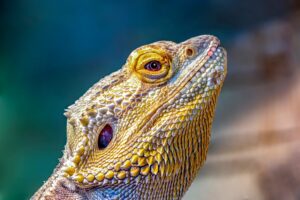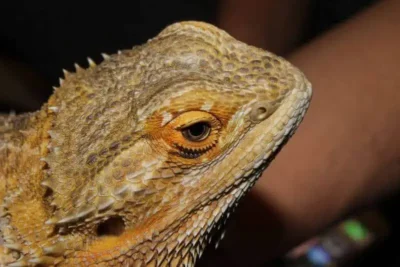Ever wondered why bearded dragons sport what seems like tiny nose plugs? These fascinating creatures have a unique feature that sets them apart in the reptile kingdom. In this article, we’ll delve into the curious world of bearded dragons and unravel the mystery behind their nose plugs.
From the intricacies of their anatomy to the evolutionary advantages, let’s uncover the reasons behind the question: “Why do bearded dragons have nose plugs?”
Bearded dragons, with their charming personalities and distinctive appearance, possess a curious feature that often piques the interest of reptile enthusiasts: nose plugs. These small, scale-covered structures, also known as nares plugs, serve a vital purpose in the life of a bearded dragon.
One primary function of the nose plugs is to aid in regulating the bearded dragon’s respiratory system. These plugs help control the airflow and maintain optimal humidity levels within their nasal passages. Bearded dragons are native to arid regions, where the air can be dry, and these nose plugs play a crucial role in preventing excessive moisture loss during respiration.
What are nose plugs?

Nose plugs are devices that are inserted into the nostrils to block them temporarily. They’re commonly used in activities where individuals need to prevent water or other substances from entering their nose, such as swimming, diving, or certain medical procedures.
Also, nose plugs come in various forms, including soft silicone plugs, clips, or even custom-molded options. They help maintain dry nasal passages and prevent water or debris from entering the nasal cavity, which can be uncomfortable or even harmful in certain situations.
Purpose of nose plugs in bearded dragons
The “nose plugs” you see on bearded dragons aren’t actually plugs at all, but rather retained shed skin on their nostrils. Shedding is a natural process for reptiles, and bearded dragons typically shed their skin in patches or even whole pieces.
During this process, a thin layer of skin can sometimes come loose inside their nostrils. This shed skin is usually soft and harmless, and the bearded dragon will usually be able to remove it themselves by rubbing their nose on rough surfaces or sneezing.
However, sometimes the shed skin can become stuck in the nostrils, which can make it difficult for the bearded dragon to breathe. If you notice that your bearded dragon has shed skin stuck in their nostrils, you can gently try to remove it with a moistened cotton swab.
Be very careful not to force it, as this could damage their delicate nostrils. If you’re not comfortable removing it yourself, or if the shed skin seems to be causing your bearded dragon any discomfort, it’s best to take them to a veterinarian.
How nose plugs help filter out particles
Nose plugs in bearded dragons primarily serve to prevent water from entering their nostrils during bathing, rather than filtering out particles. These plugs act as barriers to block water from entering the respiratory system, helping to prevent respiratory issues or infections that may arise from water aspiration.
However, in some cases, nose plugs may also offer a limited filtering effect by physically blocking larger particles from entering the nostrils. This can be beneficial if the bearded dragon is exposed to dusty or dirty environments, helping to reduce the risk of respiratory irritation or discomfort.
However, nose plugs are not specifically designed for particle filtration, and their effectiveness in this regard may be limited compared to dedicated respiratory protection methods such as air filtration systems or enclosure hygiene practices.
Importance of hydration for bearded dragons
Hydration is crucial for the health and well-being of bearded dragons, as it supports various physiological functions and helps prevent dehydration. Here are some reasons why hydration is important for bearded dragons:
- Maintains bodily functions: Adequate hydration is essential for proper organ function, including digestion, circulation, and temperature regulation. Water is vital for metabolic processes and nutrient absorption.
- Prevents dehydration: Dehydration can quickly lead to serious health issues in bearded dragons. Signs of dehydration include sunken eyes, wrinkled skin, lethargy, and loss of appetite. Ensuring your bearded dragon has access to clean water and providing regular baths can help prevent dehydration.
- Shedding: Proper hydration aids in the shedding process for bearded dragons. Hydrated skin is more elastic and easier for the dragon to shed. Inadequate hydration can lead to incomplete sheds, causing discomfort and potentially leading to complications such as retained shed.
- Kidney health: Adequate water intake supports kidney function and helps flush out waste and toxins from the body. Dehydration can strain the kidneys and increase the risk of urinary tract issues, such as kidney stones or gout.
- Overall health and vitality: Well-hydrated bearded dragons are more likely to exhibit normal behavior, have brighter colors, and maintain a healthy weight. Proper hydration contributes to their overall health and vitality.
To ensure your bearded dragon stays hydrated, provide access to fresh water at all times. Additionally, regularly offer baths to encourage drinking and help maintain hydration levels. The frequency of baths may vary depending on factors such as the age, health, and activity level of your bearded dragon, but a few times a week is generally recommended.
How nose plugs help retain moisture
Nose plugs in bearded dragons primarily serve to prevent water from entering their nostrils during bathing, rather than specifically retaining moisture. However, by blocking water from entering the respiratory system during baths, nose plugs indirectly contribute to maintaining moisture levels in the bearded dragon’s environment.
When a bearded dragon is bathed, moisture from the water can be absorbed through their skin, helping to hydrate them. However, if water enters the nostrils, it may not only pose a risk of respiratory issues but also reduce the effectiveness of absorbing moisture through the skin.
By using nose plugs during baths, caregivers can ensure that the moisture from the water remains on the surface of the skin, promoting hydration without the risk of aspiration. This can be especially beneficial for bearded dragons that may have difficulty staying hydrated through drinking alone or those prone to dehydration.
While nose plugs themselves don’t actively retain moisture, they indirectly support hydration by allowing the bearded dragon to safely absorb moisture during baths without the risk of inhaling water into their respiratory system.
Common issues with nose plugs
Common issues that may arise with nose plugs for bearded dragons include:
- Discomfort: Nose plugs that are too tight or improperly fitted can cause discomfort or irritation to the bearded dragon’s nostrils. This discomfort may lead to stress or agitation in the dragon.
- Ineffective sealing: If the nose plugs do not properly seal the nostrils, water may still enter the respiratory system during bathing, defeating the purpose of using the plugs. This can lead to respiratory issues or infections.
- Difficulty breathing: In some cases, bearded dragons may have difficulty breathing with nose plugs inserted. This can cause distress and anxiety in the dragon, potentially leading to complications if not addressed promptly.
- Risk of ingestion: Nose plugs that are not securely attached may come loose during bathing and become ingested by the bearded dragon. Ingestion of foreign objects can pose a choking hazard or cause digestive issues.
- Skin irritation: Prolonged use of nose plugs or improper fitting may cause skin irritation around the nostrils of the bearded dragon. This can lead to inflammation or sores if not addressed.
To mitigate these issues, it’s essential to use properly sized nose plugs that fit comfortably in the bearded dragon’s nostrils without causing constriction. Additionally, closely monitor the dragon during bathing to ensure the plugs remain in place and do not cause any distress.
If you notice any signs of discomfort or breathing difficulty, remove the nose plugs immediately and seek veterinary advice if necessary. Regular cleaning and inspection of the plugs can also help prevent issues such as irritation or bacterial growth.
Signs of clogged or infected nose plugs


